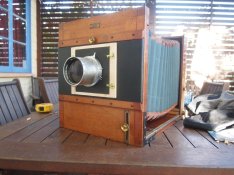Seems I bought a 24cm x 30cm camera with three plate holders, so was thinking I might as well try my hand at Tintypes. Was wondering if someone could link me to a site with some details of the process, especially the chemistry. Cant seem to find much apart from the basic process. Cant find much detail on what chemicals and amounts to use.
I live in Australia, so would be good to source most things locally. Gold street studios have some chemistry https://www.goldstreetstudios.com.au/photographic-supplies/category/wet-plate-collodion/ and I should be able to find some stuff on ebay.
Im not good with text books, already have too many I cant follow. I do best with reading off the internet and making mistakes, its the only way I learn .
.
Coarse are way too expensive for me.
A couple more quick questions, why are the silver nitrate tanks on a stand. I will probably have to make one so will need to know what angle to work to.
Also are the plates just painted black, no special paint or metal? Can get Colorbond cut to size reasonably cheaply.
Thanks.
I live in Australia, so would be good to source most things locally. Gold street studios have some chemistry https://www.goldstreetstudios.com.au/photographic-supplies/category/wet-plate-collodion/ and I should be able to find some stuff on ebay.
Im not good with text books, already have too many I cant follow. I do best with reading off the internet and making mistakes, its the only way I learn
 .
.Coarse are way too expensive for me.
A couple more quick questions, why are the silver nitrate tanks on a stand. I will probably have to make one so will need to know what angle to work to.
Also are the plates just painted black, no special paint or metal? Can get Colorbond cut to size reasonably cheaply.
Thanks.













 At least that's true for me. It gives me the feeling (whether it's correct or not) that I understand things better when I succeed in the end. It's silly if you look at it objectively, but different strokes, eh?
At least that's true for me. It gives me the feeling (whether it's correct or not) that I understand things better when I succeed in the end. It's silly if you look at it objectively, but different strokes, eh?